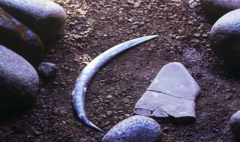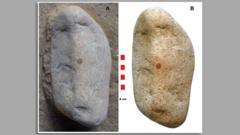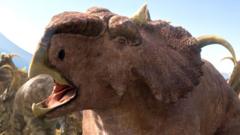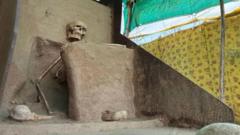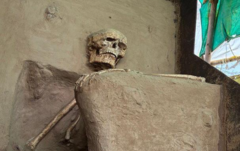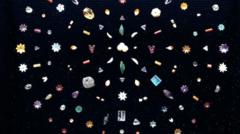Archaeologists have unveiled a magnificent private bathhouse in Pompeii during an extensive excavation, showcasing wealth and lifestyle of elite Romans. The site also holds poignant remnants of the tragic eruption of Mount Vesuvius.
Unearthing Luxury: A Lavish Bathhouse Discovered in Pompeii
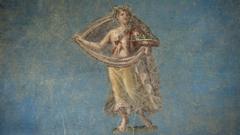
Unearthing Luxury: A Lavish Bathhouse Discovered in Pompeii
A stunning private bathhouse believed to be the largest in Pompeii reveals opulence and tragedy from the ancient city buried for millennia.
After centuries buried beneath volcanic ash, a remarkable discovery has emerged from the ancient Roman city of Pompeii: an opulent private bathhouse, possibly the largest of its kind ever found at the site. This luxurious complex features distinctly separated hot, warm, and cold rooms, sumptuous artwork, and a sizable plunge pool, illustrating the sophisticated lifestyle of the affluent Romans who once inhabited the area.
Dr. Gabriel Zuchtriegel, director of the Archaeological Park of Pompeii, emphasized the significance of these "spaces that really are part of the 'Pompeii effect'" and expressed awe at how the ruins seem as though their owners left just moments ago. The bathhouse, situated within a grand residence uncovered during the last two years, has brought new light to the lives of Pompeii's elite.
As excavations continue, the remains of two individuals offer a chilling insight into the volcanic disaster that struck in AD 79. Found in a nearby room, a woman and a young man had succumbed to the devastating pyroclastic flow that rushed through the city. The woman, aged between 35 and 50, was discovered gripping jewelry and coins, while the younger man, likely in his late teens or early 20s, lay in a cramped corner. Their positions indicate a frantic attempt to escape the wrath of Mount Vesuvius, captured in a moment of suspense.
The ongoing dig, considered the most thorough in a generation, has revealed more than just the bathhouse. An entire city block has been unveiled, revealing various establishments, including a bakery and laundry, suggesting a wealthy resident, likely Aulus Rustius Verus, owned these properties.
The bathhouse's changeless aesthetics, such as vibrant red walls and intricate mosaics, reflect the opulence of this elite lifestyle. Visitors would traverse through rooms adorned with frescoes, utilizing baths heated by a remarkable furnace system managed by enslaved individuals, starkly contrasting the lavish experience enjoyed by the wealthy.
Throughout the excavation, terms of wealth and status come to a dramatic forefront, further defined by the artifacts uncovered, including exquisite jewelry and coins, beautifully encapsulating the lives of those lost in the eruption.
The stark contrast between luxury and the harsh conditions faced by the slaves who operated the bathhouse embodies the complex social fabric of ancient Rome. As the excavation nears its conclusion, the discoveries continue to engross scholars and visitors, allowing a unique window into the daily lives and the tragedies faced by the people of Pompeii prior to its burying.
As Dr. Anna Onesti, director of the excavation, notes, surprising finds occur daily, showcasing the enduring legacy of this remarkable city. The reveals from Pompeii are not only significant historical treasures but also reminders of the dualities present in ancient societies. Visitors can look forward to engaging with these latest findings, enhancing our understanding of life in one of history's most infamous cities.








